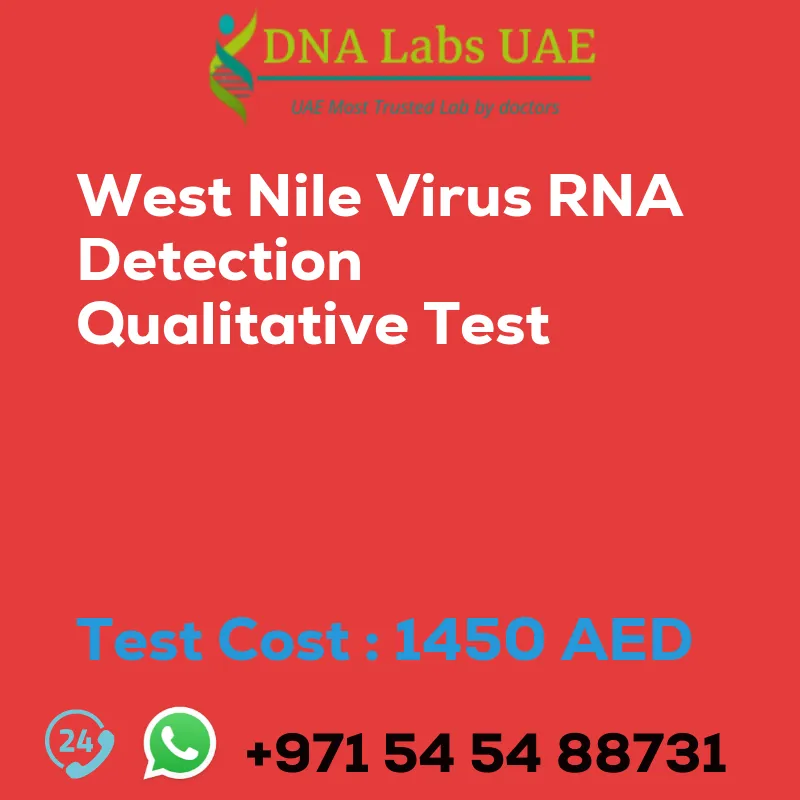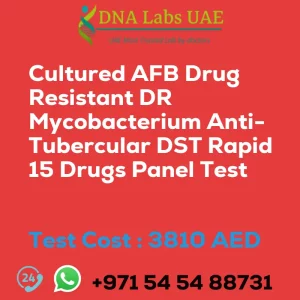West Nile Virus RNA Detection Qualitative Test
Cost: AED 1450.0
Test Name: West Nile Virus RNA Detection Qualitative Test
Components: Serum, plasma, whole blood, C.S.F
Report Delivery: 3rd Working Day (Email: 36 hours, On phone: 24 hours)
Method: Real Time PCR
Test Type: Viral
Doctor: Physician
Test Department: Genetics
Pre Test Information: Need to sign Consent document and bring any clinical history of patient for West Nile Virus (RNA Detection) Qualitative Test
Test Details
The West Nile Virus (RNA Detection) Qualitative Test is a diagnostic tool used to detect the presence of the West Nile Virus (WNV) RNA in a patient’s sample. This test is primarily used for early detection and confirmation of West Nile Virus infection.
The test relies on the detection of viral RNA, which is the genetic material of the virus. It uses a technique called reverse transcription-polymerase chain reaction (RT-PCR) to amplify and detect the specific RNA sequences of the West Nile Virus.
During the test, a small sample of blood or cerebrospinal fluid is collected from the patient. The RNA is then extracted from the sample and converted into complementary DNA (cDNA) using reverse transcription. The cDNA is then amplified using PCR, which creates millions of copies of the specific West Nile Virus RNA sequence if present in the sample.
To detect the amplified RNA, fluorescent probes or dyes specific to the West Nile Virus RNA are used. If the virus is present in the sample, the fluorescence will be detected, indicating a positive result for West Nile Virus infection. If there is no fluorescence, it means the virus is not present, and the result is negative.
The West Nile Virus (RNA Detection) Qualitative Test is highly sensitive and specific, providing accurate results for the diagnosis of West Nile Virus infection. It is commonly used in clinical laboratories and public health agencies to identify and monitor the spread of the virus.
It is important to note that this test only detects the presence of the West Nile Virus RNA and does not provide information about the severity of the infection or the patient’s immune response. Additional tests may be required to assess the patient’s condition and guide treatment decisions.
| Test Name | West Nile Virus RNA Detection Qualitative Test |
|---|---|
| Components | |
| Price | 1450.0 AED |
| Sample Condition | Serum, plasma, whole blood C.S.F |
| Report Delivery | 3rd Working Day Email:-36 hours.On phone: 24 hours |
| Method | Real Time PCR |
| Test type | Viral |
| Doctor | Physician |
| Test Department: | Genetics |
| Pre Test Information | Need to sign Consent document and bring any clinical history of patient forWest Nile Virus (RNA Detection) QualitativeTest |
| Test Details |
The West Nile Virus (RNA Detection) Qualitative Test is a diagnostic tool used to detect the presence of the West Nile Virus (WNV) RNA in a patient’s sample. This test is primarily used for early detection and confirmation of West Nile Virus infection. The test relies on the detection of viral RNA, which is the genetic material of the virus. It uses a technique called reverse transcription-polymerase chain reaction (RT-PCR) to amplify and detect the specific RNA sequences of the West Nile Virus. During the test, a small sample of blood or cerebrospinal fluid is collected from the patient. The RNA is then extracted from the sample and converted into complementary DNA (cDNA) using reverse transcription. The cDNA is then amplified using PCR, which creates millions of copies of the specific West Nile Virus RNA sequence if present in the sample. To detect the amplified RNA, fluorescent probes or dyes specific to the West Nile Virus RNA are used. If the virus is present in the sample, the fluorescence will be detected, indicating a positive result for West Nile Virus infection. If there is no fluorescence, it means the virus is not present, and the result is negative. The West Nile Virus (RNA Detection) Qualitative Test is highly sensitive and specific, providing accurate results for the diagnosis of West Nile Virus infection. It is commonly used in clinical laboratories and public health agencies to identify and monitor the spread of the virus. It is important to note that this test only detects the presence of the West Nile Virus RNA and does not provide information about the severity of the infection or the patient’s immune response. Additional tests may be required to assess the patient’s condition and guide treatment decisions. |







